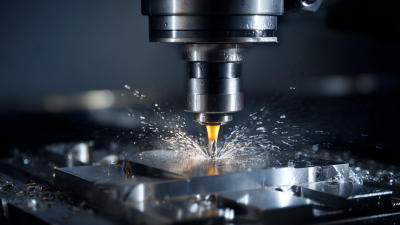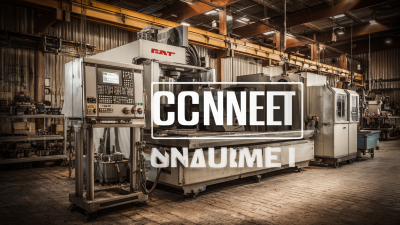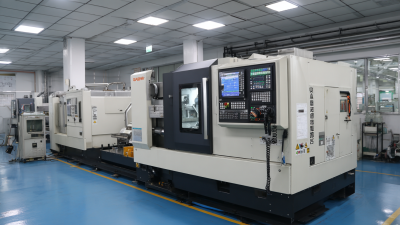How to Maximize Efficiency with Vertical CNC Machine Optimization Techniques
In the rapidly evolving landscape of manufacturing, the vertical CNC machine has emerged as a pivotal asset for enhancing production efficiency. According to a recent report by the American Machine Tool Distributors' Association, the market for CNC machines is projected to reach $100 billion by 2025, underscoring the growing reliance on advanced machining technologies.

Vertical CNC machines, known for their precision and versatility, account for over 40% of the CNC machining market, making them essential for various industries from aerospace to automotive. Optimization techniques for these machines can lead to significant reductions in cycle times—up to 30%—while improving overall product quality.
As manufacturers strive to meet the demands of a competitive market, implementing effective optimization strategies for vertical CNC machines is not just beneficial, but necessary for maximizing operational efficiency and sustaining growth.
Understanding Vertical CNC Machines: Key Features and Benefits
Vertical CNC machines play a crucial role in modern manufacturing, offering precision, efficiency, and versatility. Key features of these machines include their rigid construction, which allows for high-speed cutting with minimal vibration. According to a recent study by the Association for Manufacturing Technology, vertical CNC machines can achieve up to 30% faster production rates compared to traditional machining methods, significantly reducing lead times. Additionally, vertical CNC machining often incorporates advanced software for CAD/CAM integration, enhancing design flexibility and facilitating complex geometries that would be challenging to produce with manual machining.
The benefits of vertical CNC machines extend beyond speed; they also provide improved accuracy and repeatability, essential for industries such as aerospace and automotive, where tolerances can be as tight as ±0.001 inches. A report from the National Institute of Standards and Technology (NIST) indicates that businesses utilizing vertical CNC technology have experienced a reduction in scrap rates by nearly 20%, reflecting both material savings and enhanced process efficiency. As manufacturers continue to seek ways to optimize their operations, vertical CNC machines emerge as a vital investment for those looking to stay competitive in today’s fast-paced market.
How to Maximize Efficiency with Vertical CNC Machine Optimization Techniques
| Feature | Description | Benefit |
|---|---|---|
| High-Speed Spindle | Allows for faster cutting speeds and improved surface finishes. | Increases production rates and reduces machining time. |
| Compact Design | Requires less floor space compared to horizontal machines. | Maximizes workspace and setup efficiency. |
| Advanced Control System | Intuitive interface with real-time monitoring capabilities. | Streamlines operations and improves accuracy. |
| Tool Change Automation | Automatic tool changers reduce manual intervention. | Increases efficiency and decreases downtime. |
| Programmable Workpiece Height | Allows for adjustments to accommodate different workpieces. | Improves flexibility for various projects. |
Essential Optimization Techniques for CNC Machining Processes
In the realm of CNC machining, optimizing processes is essential to enhance efficiency and product quality. Recent advancements highlight various techniques designed to refine machining operations. For instance, finite element analysis (FEA) plays a crucial role in assessing and optimizing the dynamic and static properties of high-precision machine tools. This approach allows manufacturers to identify structural weaknesses and improve rigidity, ultimately leading to better machining performance and surface quality.
Additionally, modern techniques such as wire electric discharge machining (WEDM) have proven effective for processing challenging materials like Ti-6Al-4 V alloy. Investigations into optimization strategies, such as using hybrid algorithms for path planning in five-axis CNC systems and the SA-PSO fusion algorithm for milling integral turbine blades, underscore the importance of algorithmic approaches in enhancing machining accuracy. Furthermore, employing machine learning-enhanced methods for toolpath generation reflects a growing trend toward integrating advanced technologies in CNC machining processes, aiming for higher throughput and precision in manufacturing operations.

Implementing Advanced Tool Path Strategies to Enhance Efficiency
In the realm of CNC machining, optimizing tool paths is critical for enhancing operational efficiency. Advanced tool path strategies, such as Adaptive Clearing and Trochoidal Milling, have been shown to reduce machining time by up to 30% compared to traditional methods. According to a report by the Manufacturing Technology Association, implementing these techniques not only cuts cycle time but also extends tool life significantly—by as much as 50%—due to reduced wear and tear.
Moreover, integrating simulation software that forecasts tool paths can offer insights that lead to refined techniques for complex geometries. The use of such software can enhance first-pass yields, reducing scrap rates by up to 20%, as noted in a study by the International Journal of Advanced Manufacturing Technology. By employing these advanced strategies, manufacturers can achieve a dual benefit: improved productivity and cost-effectiveness, reinforcing the importance of tool path optimization in the competitive landscape of CNC machining.
Utilizing Real-Time Data Analytics for Performance Monitoring
Real-time data analytics plays a pivotal role in enhancing the performance of vertical CNC machines. By continuously monitoring operational parameters such as spindle speed, feed rate, and tool wear, manufacturers can gain invaluable insights into the machine's performance. This data allows for immediate adjustments, ensuring optimal cutting conditions and minimizing downtime. The integration of sensors and IoT technologies facilitates the collection of this data, enabling a seamless feedback loop that helps operators make informed decisions swiftly.
Furthermore, the application of predictive analytics can significantly reduce maintenance costs and prevent unexpected machine failures. By analyzing historical data and identifying patterns, manufacturers can forecast potential issues before they escalate. This proactive approach not only maximizes machine uptime but also extends the lifespan of equipment. Employing dashboards that visualize real-time performance metrics can further enable operators to pinpoint inefficiencies and implement corrective measures, ultimately leading to enhanced productivity and resource utilization in the manufacturing process.

Benchmarking Industry Standards: KPIs for Vertical CNC Optimization
When optimizing vertical CNC machines, benchmarking industry standards is crucial for measuring performance and enhancing efficiency. Key Performance Indicators (KPIs) serve as quantifiable metrics that help organizations identify areas for improvement. Common KPIs for vertical CNC optimization include spindle utilization, cycle time, tool wear rates, and production yield. By closely monitoring these indicators, manufacturers can compare their operations against leading industry standards, enabling them to pinpoint inefficiencies and implement necessary adjustments.
Additionally, assessing machine downtime is another critical KPI. Identifying the root causes of downtime—be it mechanical failures, tooling issues, or operational inefficiencies—enables businesses to implement targeted maintenance strategies that minimize disruptions. Moreover, tracking the rate of first-pass yield can provide insights into the effectiveness of machining processes, highlighting the need for optimization in specific areas. By leveraging these KPIs, companies can not only enhance their vertical CNC machine performance but also align their operations with the best practices in the industry, driving overall productivity forward.
Maximizing Efficiency with Vertical CNC Machine Optimization Techniques
This chart illustrates key performance indicators (KPIs) for vertical CNC machine optimization techniques, displaying metrics such as cycle time, setup time, downtime, and production rate. By analyzing these data points, manufacturers can identify areas for improvement and enhance overall efficiency.
Related Posts
-

Exploring the Best CNC Machine Alternatives for Your Manufacturing Needs
-

What is the Impact of the Best CNC Machine on Global Manufacturing Efficiency
-

7 Reasons Why Best CNC Equipment is Essential for Your Global Sourcing Strategy
-

Crafting Excellence with the Best CNC Machines from China for Global Service
-

The Ultimate Guide to Choosing the Best CNC Mill for Your Business Needs
-

Discover the Excellence of Quality China Made CNC Machine Tools for Global Markets